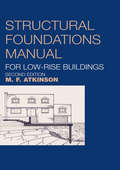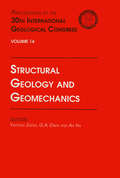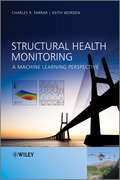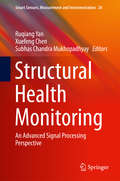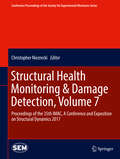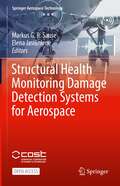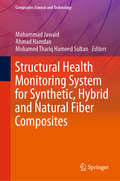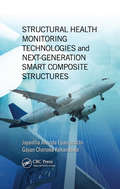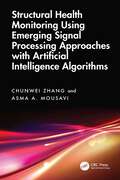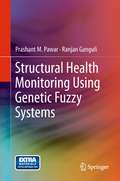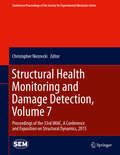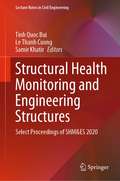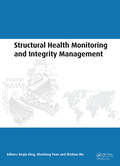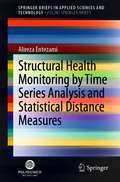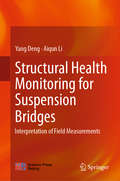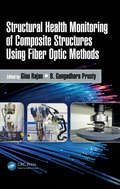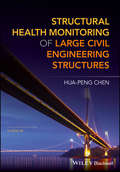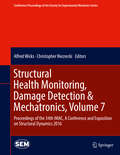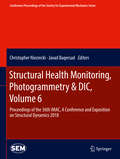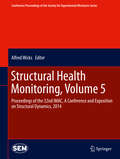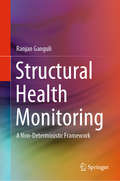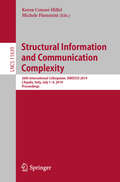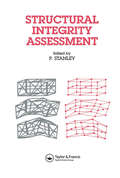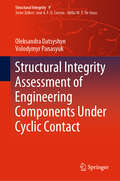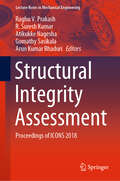- Table View
- List View
Structural Foundations Manual for Low-Rise Buildings
by Michael AtkinsonThis book provides practical and buildable solutions for the design of foundations for housing and other low-rise buildings, especially those on abnormal or poor ground. A wealth of expert information and advice is brought together dealing with the key aspects a designer must consider in order to achieve effective and economic foundation designs. This second edition of Structural Foundations Manual for Low-Rise Buildings has been completely updated in line with the new government guidelines on contaminated land and brown-field sites. The book includes well-detailed design solutions and calculations, actual case histories, illustrations, design charts and check lists, making it a user-friendly reference for contractors, structural engineers, architects and students who have to deal with foundations for low-rise buildings on sites with difficult ground conditions.
Structural Geology and Geomechanics: Proceedings of the 30th International Geological Congress, Volume 14
by YADONG ZHENG, G.A. DAVIS AND AN YINThe 30th International Geological Congress was held in Beijing, China in August 1997. Leading scientists convened to present their findings and views to the international geological research community. Volume 14 of 26 focuses on structural geology and geomechanics. All articles in the proceedings have been refereed and keynote papers have been included in Volume 1. These proceedings aim to present a view of contemporary geology and should be of interest to researchers in the geological sciences.
Structural Health Monitoring
by Charles R. Farrar Keith WordenWritten by global leaders and pioneers in the field, this book is a must-have read for researchers, practicing engineers and university faculty working in SHM.Structural Health Monitoring: A Machine Learning Perspective is the first comprehensive book on the general problem of structural health monitoring. The authors, renowned experts in the field, consider structural health monitoring in a new manner by casting the problem in the context of a machine learning/statistical pattern recognition paradigm, first explaining the paradigm in general terms then explaining the process in detail with further insight provided via numerical and experimental studies of laboratory test specimens and in-situ structures. This paradigm provides a comprehensive framework for developing SHM solutions.Structural Health Monitoring: A Machine Learning Perspective makes extensive use of the authors' detailed surveys of the technical literature, the experience they have gained from teaching numerous courses on this subject, and the results of performing numerous analytical and experimental structural health monitoring studies.Considers structural health monitoring in a new manner by casting the problem in the context of a machine learning/statistical pattern recognition paradigmEmphasises an integrated approach to the development of structural health monitoring solutions by coupling the measurement hardware portion of the problem directly with the data interrogation algorithmsBenefits from extensive use of the authors' detailed surveys of 800 papers in the technical literature and the experience they have gained from teaching numerous short courses on this subject.
Structural Health Monitoring
by Ruqiang Yan Subhas Chandra Mukhopadhyay Xuefeng ChenThe book has focussed on the different aspects of sensing technology, i. e. high reliability, adaptability, recalibration, information processing, data fusion, validation and integration of novel and high performance sensors specifically aims to use to inspect mechanical health of structure and similar applications. This book is dedicated to Sensing systems for Structural Health Monitoring offers to variety of users, namely, Master and PhD degree students, researchers, practitioners, especially Civil and Construction engineers. The book will provide an opportunity of a dedicated and a deep approach in order to improve their knowledge in this specific field.
Structural Health Monitoring & Damage Detection, Volume 7
by Christopher NiezreckiStructural Health Monitoring & Damage Detection, Volume 7: Proceedings of the 33rd IMAC, A Conference and Exposition on Structural Dynamics, 2015, the seventh volume of ten from the Conference brings together contributions to this important area of research and engineering. The collection presents early findings and case studies on fundamental and applied aspects of Structural Dynamics, including papers on: Structural Health Monitoring Damage Detection Energy Harvesting
Structural Health Monitoring Damage Detection Systems for Aerospace (Springer Aerospace Technology)
by Markus G. R. Sause Elena JasiūnienėThis open access book presents established methods of structural health monitoring (SHM) and discusses their technological merit in the current aerospace environment. While the aerospace industry aims for weight reduction to improve fuel efficiency, reduce environmental impact, and to decrease maintenance time and operating costs, aircraft structures are often designed and built heavier than required in order to accommodate unpredictable failure. A way to overcome this approach is the use of SHM systems to detect the presence of defects. This book covers all major contemporary aerospace-relevant SHM methods, from the basics of each method to the various defect types that SHM is required to detect to discussion of signal processing developments alongside considerations of aerospace safety requirements. It will be of interest to professionals in industry and academic researchers alike, as well as engineering students.This article/publication is based upon work from COST Action CA18203 (ODIN - http://odin-cost.com/), supported by COST (European Cooperation in Science and Technology). COST (European Cooperation in Science and Technology) is a funding agency for research and innovation networks. Our Actions help connect research initiatives across Europe and enable scientists to grow their ideas by sharing them with their peers. This boosts their research, career and innovation.
Structural Health Monitoring System for Synthetic, Hybrid and Natural Fiber Composites (Composites Science and Technology)
by Mohammad Jawaid Mohamed Thariq Hameed Sultan Ahmad HamdanThis book covers the basic principle and challenges of structural health monitoring system for natural fibre and the hybrid composites structural materials in industrial applications, such as building, automotive, aerospace and wind turbine. Structural health monitoring (SHM) has become crucial in evaluating the performance of structural application in recent trends, especially since it is in line with the high-tech strategy of Industry 4.0. It is a system that is operated in real time or in an online situation. Hence, it also has advantages for damage detection, damage localisation, damage assessment and life prediction compared to the non-destructive test (NDT) which is conducted offline. The book covers the monitoring of the composite materials in terms of structural properties and damage evaluation through modelling and prediction of failure in composite. It includes recent examples and real-world engineering application to illustrate the understanding of the current technology application. The book benefits lecturers, students, researchers, engineers and industrialist who are working in the civil, aerospace and wind turbine industries.
Structural Health Monitoring Technologies and Next-Generation Smart Composite Structures (Composite Materials)
by Gayan Chanaka Kahandawa Jayantha Ananda EpaarachchiDue to the increased use of composite materials in aerospace, energy, automobile, and civil infrastructure applications, concern over composite material failures has grown, creating a need for smart composite structures that are able to self-diagnose and self-heal. Structural Health Monitoring Technologies and Next-Generation Smart Composite Structures provides valuable insight into cutting-edge advances in SHM, smart materials, and smart structures. Comprised of chapters authored by leading researchers in their respective fields, this edited book showcases exciting developments in general embedded sensor technologies, general sensor technologies, sensor response interrogation and data communication, damage matrix formulation, damage mechanics and analysis, smart materials and structures, and SHM in aerospace applications. Each chapter makes a significant contribution to the prevention of structural failures by describing methods that increase safety and reduce maintenance costs in a variety of SHM applications.
Structural Health Monitoring Using Emerging Signal Processing Approaches with Artificial Intelligence Algorithms
by Chunwei Zhang Asma A. MousaviStructural health monitoring is a powerful tool across civil, mechanical, automotive, and aerospace engineering, allowing the assessment and measurement of physical parameters in real time. Processing changes in the vibration signals of a dynamic system can detect, locate, and quantify any damage existing in the system. This book presents a comprehensive state‑of‑the‑art review of the applications in time, frequency, and time‑frequency domains of signal‑processing techniques for damage perception, localization, and quantification in various structural systems.Experimental investigations are illustrated, including the development of a set of damage indices based on the signal features extracted through various signal‑processing techniques to evaluate sensitivity in damage identification. Chapters summarize the application of the Hilbert–Huang transform based on three decomposition methods such as empirical mode decomposition, ensemble empirical mode decomposition, and complete ensemble empirical mode decomposition with adaptive noise. Also, the chapters assess the performance and sensitivity of different approaches, including multiple signal classification and empirical wavelet transform techniques in damage detection and quantification. Artificial neural networks for automated damage identification are introduced.This book suits students, engineers, and researchers who are investigating structural health monitoring, signal processing, and damage identification of structures.
Structural Health Monitoring Using Genetic Fuzzy Systems
by Prashant M. Pawar Ranjan GanguliStructural health monitoring (SHM) has emerged as a prominent research area in recent years owing to increasing concerns about structural safety, and the need to monitor and extend the lives of existing structures. Structural Health Monitoring Using Genetic Fuzzy Systems elaborates the process of intelligent SHM development and implementation using the evolutionary system. The use of a genetic algorithm automates the development of the fuzzy system, and makes the method easy to use for problems involving a large number of measurements, damage locations and sizes; such problems being typical of SHM. The ideas behind fuzzy logic, genetic algorithms and genetic fuzzy systems are also explained. The functionality of the genetic fuzzy system architecture is elucidated within a case-study framework, covering: * SHM of beams; * SHM of composite tubes; and * SHM of helicopter rotor blades. Structural Health Monitoring Using Genetic Fuzzy Systems will be useful for aerospace, civil and mechanical engineers working with structures and structured components. It will also be useful for computer scientists and applied mathematicians interested in the application of genetic fuzzy systems to engineering problems.
Structural Health Monitoring and Damage Detection, Volume 7
by Christopher NiezreckiStructural Health Monitoring & Damage Detection, Volume 7: Proceedings of the 33rd IMAC, A Conference and Exposition on Structural Dynamics, 2015, the seventh volume of ten from the Conference brings together contributions to this important area of research and engineering. The collection presents early findings and case studies on fundamental and applied aspects of Structural Dynamics, including papers on: Structural Health Monitoring Damage Detection Energy Harvesting
Structural Health Monitoring and Engineering Structures: Select Proceedings of SHM&ES 2020 (Lecture Notes in Civil Engineering #148)
by Tinh Quoc Bui Le Thanh Cuong Samir KhatirThe book presents the select proceedings of International Conference on Structural Health Monitoring and Engineering Structures (SHM&ES) 2020. It brings together different applied and technological aspects of structural health monitoring. The main topics covered in this book include damage assessment, structural health monitoring, engineering fracture mechanics, Inverse problem using optimization techniques, machine learning, deep learning, Artificial intelligent and non-destructive evaluation. It will be a reference for professionals and students in the areas of civil engineering, applied natural sciences and engineering management.
Structural Health Monitoring and Integrity Management: Proceedings of the 2nd International Conference of Structural Health Monitoring and Integrity Management (ICSHMIM 2014), Nanjing, China, 24-26 September 2014
by Keqin Ding Shenfang Yuan Zhishen WuStructural Health Monitoring and Integrity Management is a collection of the papers presented at the 2nd International Conference of Structural Health Monitoring and Integrity Management (ICSHMIM2014, Nanjing, China, 24-26 September 2014), and addresses the most recent developments in the field of Structural Health Monitoring (SHM) and integrity ma
Structural Health Monitoring by Time Series Analysis and Statistical Distance Measures (SpringerBriefs in Applied Sciences and Technology)
by Alireza EntezamiThis book conducts effective research on data-driven Structural Health Monitoring (SHM), and accordingly presents many novel feature extraction methods by time series analysis and signal processing, to extract reliable damage sensitive features from vibration responses. In this regard, some limitations of time series modeling are dealt with. For decision-making, innovative distance-based novelty detection techniques are presented to detect, locate, and quantify different damage scenarios. The performance of the presented methods is demonstrated via laboratory and full-scale structures along with several comparative studies. The main target audience of the book includes scholars, graduate students working on SHM via statistical pattern recognition in terms of feature extraction and classification for damage diagnosis under environmental and operational variations; it would also be beneficial for practicing engineers whose work involves these topics.
Structural Health Monitoring for Suspension Bridges: Interpretation of Field Measurements
by Yang Deng Aiqun LiThis book presents extensive information on structural health monitoring for suspension bridges. During the past two decades, there have been significant advances in the sensing technologies employed in long-span bridge health monitoring. However, interpretation of the massive monitoring data is still lagging behind. This book establishes a series of measurement interpretation frameworks that focus on bridge site environmental conditions, and global and local responses of suspension bridges. Using the proposed frameworks, it subsequently offers new insights into the structural behaviors of long-span suspension bridges. As a valuable resource for researchers, scientists and engineers in the field of bridge structural health monitoring, it provides essential information, methods, and practical algorithms that can facilitate in-service bridge performance assessments.
Structural Health Monitoring of Composite Structures Using Fiber Optic Methods (Devices, Circuits, and Systems)
by Ginu Rajan and B. Gangadhara PrustyThis highly comprehensive, introductory book explains the basics of structural health monitoring aspects of composite structures. This book serve as an all-in-one reference book in which the reader can receive a basic understanding of composite materials, manufacturing methods, the latest types of optical fiber sensors used for structural health monitoring of composite structures, and demonstrated applications of the use of fiber sensors in a variety of composite material structures. The content draws upon the authors’ and distinguished contributors’ extensive research/teaching and industrial experience to fully cover the structural health monitoring of composite materials using fiber optic sensing methods.
Structural Health Monitoring of Large Civil Engineering Structures
by Hua-Peng ChenA critical review of key developments and latest advances in Structural Health Monitoring technologies applied to civil engineering structures, covering all aspects required for practical application Structural Health Monitoring (SHM) provides the facilities for in-service monitoring of structural performance and damage assessment, and is a key element of condition based maintenance and damage prognosis. This comprehensive book brings readers up to date on the most important changes and advancements in the structural health monitoring technologies applied to civil engineering structures. It covers all aspects required for such monitoring in the field, including sensors and networks, data acquisition and processing, damage detection techniques and damage prognostics techniques. The book also includes a number of case studies showing how the techniques can be applied in the development of sustainable and resilient civil infrastructure systems. Structural Health Monitoring of Large Civil Engineering Structures offers in-depth chapter coverage of: Sensors and Sensing Technology for Structural Monitoring; Data Acquisition, Transmission, and Management; Structural Damage Identification Techniques; Modal Analysis of Civil Engineering Structures; Finite Element Model Updating; Vibration Based Damage Identification Methods; Model Based Damage Assessment Methods; Monitoring Based Reliability Analysis and Damage Prognosis; and Applications of SHM Strategies to Large Civil Structures. Presents state-of-the-art SHM technologies allowing asset managers to evaluate structural performance and make rational decisions Covers all aspects required for the practical application of SHM Includes case studies that show how the techniques can be applied in practice Structural Health Monitoring of Large Civil Engineering Structures is an ideal book for practicing civil engineers, academics and postgraduate students studying civil and structural engineering.
Structural Health Monitoring, Damage Detection & Mechatronics, Volume 7
by Alfred Wicks Christopher NiezreckiStructural Health Monitoring, Damage Detection & Mechatronics, Volume 7. Proceedings of the 34th IMAC, A Conference and Exposition on Dynamics of Multiphysical Systems: From Active Materials to Vibroacoustics, 2016, the seventh volume of ten from the Conference brings together contributions to this important area of research and engineering. The collection presents early fi ndings and case studies on fundamental and applied aspects of Structural Dynamics, including papers on: * Structural Health Monitoring * Damage Detection * Numerical Modeling * Mechatronics * System Identifi cation * Active Controls
Structural Health Monitoring, Photogrammetry & DIC, Volume 6: Proceedings Of The 36th Imac, A Conference And Exposition On Structural Dynamics 2018 (Conference Proceedings of the Society for Experimental Mechanics Series)
by Christopher Niezrecki Javad BaqersadStructural Health Monitoring Photogrammetry & DIC, Volume 6: Proceedings of the 36th IMAC, A Conference and Exposition on Structural Dynamics, 2018, the sixth volume of nine from the Conference brings together contributions to this important area of research and engineering. The collection presents early findings and case studies on fundamental and applied aspects of Structural Health Monitoring & Damage Detection, including papers on:Structural Health MonitoringDamage DetectionSystem IdentificationActive Controls
Structural Health Monitoring, Volume 5
by Alfred WicksThis fifth volume of eight from the IMAC - XXXII Conference, brings together contributions to this important area of research and engineering. The collection presents early findings and case studies on fundamental and applied aspects of Structural Dynamics, including papers on: Linear Systems Substructure Modelling Adaptive Structures Experimental Techniques Analytical Methods Damage Detection Damping of Materials & Members Modal Parameter Identification Modal Testing Methods System Identification Active Control Modal Parameter Estimation Processing Modal Data
Structural Health Monitoring: A Non-Deterministic Framework
by Ranjan GanguliThis book discusses systems of damage detection and structural health monitoring in mechanical, civil, and aerospace structures. It utilizes principles of fuzzy logic, probability theory, and signal processing to develop systems and approaches that are robust in the presence of both noise in the data and variations in properties of materials which are intrinsic to the process of mass production. This volume will be useful to graduate students, researchers, and engineers working in this area, especially those looking to understand and address model uncertainty in their algorithms.
Structural Information and Communication Complexity: 26th International Colloquium, SIROCCO 2019, L'Aquila, Italy, July 1–4, 2019, Proceedings (Lecture Notes in Computer Science #11639)
by Michele Flammini Keren Censor-HillelThis book constitutes the refereed conference proceedings of the 26th International Colloquium on Structural Information and Communication Complexity, SIROCCO 2019, held in L’Aquila, Italy, in July 2019.The 19 full papers and 9 short papers presented in this book were carefully reviewed and selected from 39 submissions. They are devoted to the study of the interplay between structural knowledge, communication, and computing in decentralized systems of multiple communicating entities.
Structural Integrity Assessment
by P. StanleyThe assessment of structural integrity is a vitally important consideration in many fields of engineering, which has an influence on the full range of professional activities from conception, design and analysis, through operation to residual life evaluation and possible life extension. In devising satisfactory procedures for this purpose there is
Structural Integrity Assessment of Engineering Components Under Cyclic Contact (Structural Integrity #9)
by Oleksandra Datsyshyn Volodymyr PanasyukThis book focuses on surface layers fracture of cyclical contacting bodies (machine parts). Calculation models and calculating procedures of stress-strain states of cyclically contacting solids with cracks, are included. Recommendations for the optimization of operating parameters of joints (contact stresses magnitude, friction/lubrication conditions, materials crack resistance etc) for elements of rolling pairs (wheel–rail systems, backup roll – working roll of rolling mills etc.) and some fretting pairs are formulated.
Structural Integrity Assessment: Proceedings of ICONS 2018 (Lecture Notes in Mechanical Engineering)
by Raghu V. Prakash R. Suresh Kumar Atikukke Nagesha Gomathy Sasikala Arun Kumar BhaduriThis volume contains selected papers from the Second Quadrennial International Conference on Structural Integrity (ICONS-2018). The papers cover important topics related to structural integrity of critical installations, such as power plants, aircrafts, spacecrafts, defense and civilian components. The focus is on assuring safety of operations with high levels of reliability and structural integrity. This volume will be of interest to plant operators working with safety critical equipment, engineering solution providers, software professionals working on engineering analysis, as well as academics working in the area.
